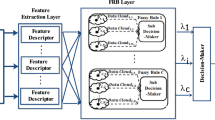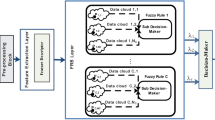Abstract
Biometric technology knows a large attention in the recent years. In the biometric security systems, the personal identity recognition depends on their behavioral, biological or physical characteristics. Currently, a number of biometrics technologies are developed and one of the most popular biometric trait is finger-knuckle-print (FKP) due to the user-friendly and the low cost. This paper presents a new approach, where the deep learning is applied to create a multi-modal biometric system based on images of FKP modalities which extracted their features by principal component analysis Network (PCANet). In the proposed structure, PCA is employed to learn two-stage of filter banks followed by simple binary hashing and block histograms for clustering at feature vectors, which is adopt as input for classification by linear multiclass Support Vector Machine (SVM). To improve the recognition rates, a multimodal biometric system based on matching score level fusion scheme was generated. Using an available FKP database, we conducted a series of identification experiments and the obtained results show that the design of our identification system achieves an excellent recognition rate and having high anti-counterfeiting capability.






Similar content being viewed by others
References
Angelov P, Gu X (2017) MICE: multi-layer multi-model images classifier ensemble. In: 3rd IEEE international conference on cybernetics (CYBCONF 2017), Exeter, UK, pp 1–8. https://doi.org/10.1109/CYBConf.2017.7985788
Baochang Z (2010) Local derivative pattern versus local binary pattern: face recognition with high-order local pattern descriptor. IEEE Trans Image Process 19(2):533–544
Belgacem N, Fournier R, Nait-Ali A, Bereksi-Reguig F (2015) A novel biometric authentication approach using ECG and EMG signals. J Med Eng Technol 39(4):226–238
Chan T, Jia K, Gao S, Lu J, Zeng Z, Ma Y (2015) PCANet: a simple deep learning baseline for image classification. IEEE Trans Image Process 24:5017
Chang Y, Li W, Yang Z (2017) Network intrusion detection based on random forest and support vector machine. In: IEEE international conference on computational science and engineering (CSE) and IEEE international conference on embedded and ubiquitous computing (EUC), vol 1, pp 635–638
Deng L (2013) A deep convolutional neural network using heterogeneous pooling for trading acoustic invariance with phonetic confusion. In: Proceedings of IEEE international conference of acoustic speech signal process (ICASSP), pp 6669–6673
Donahue J, Jia Y, Vinyals O (2013) DeCAF: a deep convolutional activation feature for generic visual recognition. Comput Sci 50(1):815–830
Esposito A, Marinaro M, Oricchio D, Scarpetta S (2000) Approximation of continuous and discontinuous mappings by a growing neural RBF-based algorithm. Neural Netw 12:651–665
Feng ZY, Jin LW, Tao DP, Huang SP (2015) DLANet: a manifold-learning-based discriminative feature learning network for scene classification. Neurocomputing 157:11–21
Fierrez-Aguilar J, Ortega-Garcia J, Gonzalez-Rodriguez J (2005) Target dependent score normalization techniques and their application to signature verification. IEEE Trans Syst Man Cybern C Appl Rev 35(3):418–425
Ghazi MM, Ekenel HK (2016) A comprehensive analysis of deep learning based representation for face recognition. In: Proceedings of the IEEE conference on computer vision and pattern recognition workshops, Las Vegas, USA, pp 34–41
Gu X, Angelov PP (2018) Self-organising fuzzy logic classifier. Inf Sci 447:36–51. https://doi.org/10.1016/j.ins.2018.03.004
Gu X, Angelov PP, Zhang C, Atkinson PM (2018) A massively parallel deep rule-based ensemble classifier for remote sensing scenes. IEEE Geosci Remote Sens Lett 15(3):345–349. https://doi.org/10.1109/LGRS.2017.2787421
Hinton GE, Osindero S, Teh Y-W (2006) A fast learning algorithm for deep belief nets. Neural Comput 18(7):1527–1554
Karki MV, Selvi SS (2013) Multimodal biometrics at feature level fusion using texture features. Int J Biometr Bioinf 7(1):58–73
Kasabov N (2007) Evolving connectionist systems: the knowledge engineering approach, 2nd edn. Springer, New York
Kaur G, Yadav AK, Chaudhary S (2014) An improved approach to multibiometrics security. Int J Comput Sci Commun 5(1):181–187
Krizhevsky A, Sutskever I, Hinton GE (2012) Imagenet classification with deep convolutional neural networks. In: Advances in neural information processing systems 25. Curran Associates, Inc., New York, pp 1097–1105
Kumar A, Ravikant Ch (2009) Personal authentication using finger knuckle surface. IEEE Trans Inf Forensics Secur 4(1):98–109
Marchi E, Vesperini F, Eyben F, Squartini S, Schuller B (2015) A novel approach for automatic acoustic novelty detection using a denoising autoencoder with bidirectional LSTM neural networks. In: IEEE international conference on acoustics, speech, and signal processing (ICASSP’15), IEEE, Brisbane, Australia, p 5
Meraoumia A, Korichi M, Bendjenna H, Chitroub S (2016) Multispectral palmprint identification method using rotation invariant variance measures. In: IEEE international conference on information technology for organizations development (IT4OD), Fez, Morocco, pp 1–6
Meraoumia A, Laimeche L, Bendjenna H, Chitroub S (2016) Do we have to trust the deep learning methods for palmprints identification? In: Proceedings of the mediterranean conference on pattern recognition and artificial intelligence, Tebessa, Algeria, pp 85–91
Nakanishi I, Sodani Y (2010) SVM-based biometric authentication using intra-body propagation signals. In: Seventh IEEE international conference on advanced video and signal based surveillance (AVSS), pp 561–566
Oquab M, Bottou L, Laptev I, Sivic J (2014) Learning and transferring mid-level image representations using convolutional neural networks. In: Proceedings of IEEE conference of computer vision pattern recognition, pp 1717–1724
Pang S, Ban T, Kadobayashi Y, Kasabov N (2011) Personalized mode transductive spanning SVM classification tree. Inf Sci 181(11):2071–2085
Razavian AS, Azizpour H, Sullivan J (2014) CNN features off-the-shelf: an astounding baseline for recognition. In: Computer vision and pattern recognition workshops, pp 24–29
Schmidhuber J (2015) Deep learning in neural networks: an overview. Neural Netw 61:85–117
Sudhamani MJ, Venkatesha MK, Radhika KR (2012) Revisiting feature level and score level fusion techniques in multimodal biometrics system. In: Proceedings of international conference on multimedia computing and systems (ICMCS), pp 881–885
Taigman Y, Yang M, Ranzato MA, Wolf L (2014) DeepFace: closing the gap to human-level performance in face verification. In: Proceedings of the IEEE conference on computer vision and pattern recognition, Columbus, USA, pp 23–28, 1701–1708
The Hong Kong Polytechnic University (PolyU) (2018) Finger-Knuckle-Print Database. http://www.comp.polyu.edu.hk/~biometrics/FKP.htm
Tian L, Fan CX, Ming Y, Jin Y (2015) Stacked PCA network (SPCANet): an effective deep learning for face recognition. In: Proceedings of IEEE international conference digital signal processing, pp 1039–1043
Upadhayay R, Yadav RK (2013) Kernel principle component analysis in face recognition system: a survey. Int J Adv Res Comput Sci Softw Eng 3(6):348–353
Zhang D, Kong W, You J, Wong M (2003) Online palmprint identification. IEEE Trans Pattern Anal Mach Intell 25(9):10411050
Author information
Authors and Affiliations
Corresponding author
Additional information
Publisher’s Note
Springer Nature remains neutral with regard to jurisdictional claims in published maps and institutional affiliations.
Rights and permissions
About this article
Cite this article
Chlaoua, R., Meraoumia, A., Aiadi, K.E. et al. Deep learning for finger-knuckle-print identification system based on PCANet and SVM classifier. Evolving Systems 10, 261–272 (2019). https://doi.org/10.1007/s12530-018-9227-y
Received:
Accepted:
Published:
Issue Date:
DOI: https://doi.org/10.1007/s12530-018-9227-y




